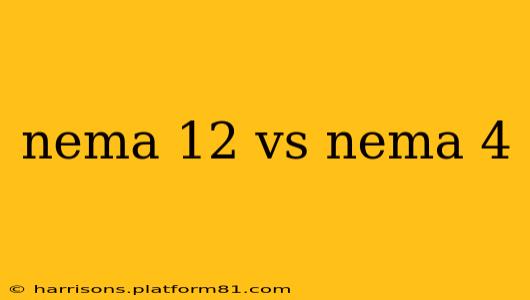Choosing the right enclosure for your electrical equipment is crucial for safety and longevity. Two common ratings you'll encounter are NEMA 12 and NEMA 4. While both offer protection, they cater to different environments and levels of hazard. This comprehensive guide will break down the key differences between NEMA 12 and NEMA 4 enclosures, helping you make an informed decision for your specific needs.
What Does NEMA Stand For?
NEMA stands for the National Electrical Manufacturers Association. They establish standards for various electrical products, including enclosures, ensuring consistency and safety across the industry. NEMA ratings, like NEMA 12 and NEMA 4, define the level of protection offered against environmental factors and hazards.
NEMA 12 Enclosures: Indoor Protection
NEMA 12 enclosures provide protection against:
- Dust: They prevent the accumulation of dust and airborne particles, ensuring the internal components remain clean and functional.
- Falling Debris: They offer a degree of protection against the ingress of falling debris or light impacts.
- Indirect Contact: The enclosure design prevents accidental contact with live components, improving safety for personnel.
Ideal Applications for NEMA 12 Enclosures:
NEMA 12 enclosures are primarily suitable for indoor environments where the risk of water ingress, heavy impacts, or corrosive elements is minimal. Common applications include:
- Industrial control panels: In controlled indoor factory settings.
- Commercial buildings: Protecting electrical equipment in office spaces or retail environments.
- Cleanroom environments: Where dust and particulate matter are a concern.
Limitations of NEMA 12 Enclosures:
NEMA 12 enclosures offer limited protection against liquids, moisture, and direct impacts. They are not suitable for outdoor use or harsh environments where exposure to water, chemicals, or heavy impacts is likely.
NEMA 4 Enclosures: Watertight and Weatherproof Protection
NEMA 4 enclosures provide a higher level of protection compared to NEMA 12, guarding against:
- Water: They are designed to be watertight, preventing the ingress of splashing water or hose-directed water.
- Dust: Similar to NEMA 12, they offer protection against dust accumulation.
- Corrosion: NEMA 4 enclosures often utilize materials resistant to corrosion, extending their lifespan in challenging environments.
Ideal Applications for NEMA 4 Enclosures:
NEMA 4 enclosures are ideal for outdoor applications and environments where exposure to water is a significant factor. Examples include:
- Outdoor electrical equipment: Protecting equipment in exposed locations like parking garages or construction sites.
- Industrial wash-down areas: Protecting equipment in environments requiring frequent cleaning with water jets.
- Marine applications: Providing protection against saltwater and humidity.
Limitations of NEMA 4 Enclosures:
While NEMA 4 enclosures offer significant protection against water, they may not be sufficient for submersion or extremely high-pressure water jets. They also might not offer sufficient protection against exceptionally harsh chemicals or extreme temperatures without additional modifications.
NEMA 12 vs. NEMA 4: A Quick Comparison Table
| Feature | NEMA 12 | NEMA 4 |
|---|---|---|
| Water Protection | Limited; no water ingress protection | Watertight; resists splashing water and hose-directed water |
| Dust Protection | Protects against dust accumulation | Protects against dust accumulation |
| Impact Resistance | Limited | Moderate |
| Typical Applications | Indoor, controlled environments | Outdoor, wash-down areas |
| Cost | Generally less expensive | Generally more expensive |
What are the differences in cost between NEMA 12 and NEMA 4 enclosures?
The cost difference between NEMA 12 and NEMA 4 enclosures stems from the increased materials and manufacturing complexity required for the higher level of protection offered by NEMA 4. NEMA 4 enclosures often utilize more robust materials, more complex seals, and more stringent quality control procedures, resulting in a higher price tag.
What are the different types of NEMA ratings?
NEMA offers a wide array of enclosure ratings beyond just NEMA 12 and NEMA 4, each designed for specific environmental conditions and hazards. Other common ratings include NEMA 3R (outdoor use, raintight), NEMA 6 (dust-tight and watertight), and NEMA 13 (oil-tight). The specific rating needed depends entirely on the operating environment and potential hazards.
Conclusion
Selecting the right NEMA enclosure is crucial for ensuring the safety and longevity of your electrical equipment. Understanding the differences between NEMA 12 and NEMA 4, and the specific protection each offers, allows you to make the best choice based on your application's requirements. Always consult the relevant NEMA standards for detailed specifications and ensure your chosen enclosure meets all applicable safety regulations.
